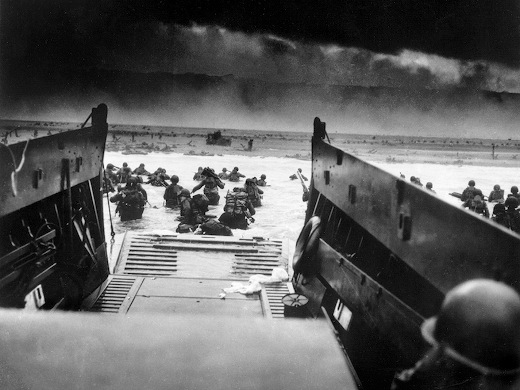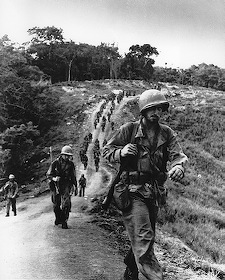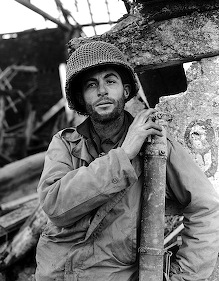FALL TV PREVIEW: The War (PBS)
09/21/07 03:28 PM

Premiering: Sunday night, Sept. 23 at 8 p.m. (central) on PBS. Continuing Monday through Wednesday and then Sept. 30 to Oct. 2
Directed and produced by: Ken Burns, Lynn Novick
Written by: Geoffrey Ward
Narrated by: Keith David
By ED BARK
There's a certain truth to this, even though it's patently false. History hasn't really happened yet until filmmaker Ken Burns gets around to it.
He bites off a gargantuan chunk with PBS's The War, a roughly 15-hour look into the agony and ecstasy of America's bloodily triumphant victories over aggressors Germany and Japan.
Many have have come before him in this endeavor. So it seems as if people of a certain age should know World War II by heart. But Burns of course bears witness as others simply can't. Quibble with his by now standard touches, first manifested in full with 1990's landmark The Civil War. But in the end -- for those who stick it out -- it's impossible not to salute him for a monumental melding of images, music, eyewitness recollections, writing (by longtime collaborator Geoffrey Ward) and narration (again from the redoubtable Keith David).
The War perhaps is a bit melodramatic at times. And Lord knows it's easy to quickly tire of the thick-as-molasses musings of Mobile, Alabama's deep-drawling Katharine Phillips. Still, that's a bit like saying that a perfect night at a 5-star restaurant was spoiled by the sight of a stray crumb on white linen. There is too much of inestimable worth to pay her too much mind.
Each of the documentary's seven chapters begins with a printed disclaimer of sorts: "The Second World War was fought in thousands of places, too many for any one accounting. This is the story of four American towns and how their citizens experienced that war."
Said towns are Mobile, Luverne, Minn., Waterbury, Conn. and Sacramento, CA. And few if any of the townies are any more eloquent than soft-spoken Sam Hynes of Luverne, a former Marine Corps pilot.
"I don't think there's such a thing as a good war," he says in setting the table Sunday night. "There are sometimes necessary wars."
Narrator David, never better than this, then weighs in with another overview that can't be denied. "The Second World War brought out the best and the worst in a generation, and blurred the two so that they at times became almost indistinguishable."
In Wednesday night's Chapter 4, WWII veteran Daniel Inouye of Hawaii, a U.S. senator since 1963, talks matter-of-factly about the elation he experienced after drawing a bead on a German soldier and then claiming him as his first combat kill.
"I felt pleasure, and the men applauded," he says. Inouye killed many more times, lost his right arm in battle and won a Medal of Honor. Unlike some among a dwindling number of surviving veterans, he seems to have survived without any ghosts or nightmares from the horrors he witnessed and in some cases perpetrated.
Not so Glenn Frazier of Alabama, a survivor of the infamous Bataan death march who then spent the rest of the war being further mistreated in various Japanese prison camps.
"I did not want my body pushin' up Japanese daisies," he says of his will to survive.
Frazier also hoped to reconnect with a woman back home who spurned his love and prompted his enlistment. It turned out she had reconsidered and was eagerly awaiting his return. But it got harder and harder to hold a candle for a presumed dead man.
Finally safe back home, Frazier spent much of his next 35 years haunted by those experiences and consumed by a hatred for the Japanese. His first-person recollections speak for many who were never quite whole again after a war that took the lives of more than 405,000 American serviceman. Amazingly, those were by far the fewest casualties of a major combatant.


Burns and his longtime collaborator, Lynn Novick, bring many a ghastly image to the screen in telling the full story of WWII. Still pictures and film from the German concentration camps are horrific testaments to why the U.S. had to fight and prevail. And the killing grounds of Okinawa are indeed, as one soldier put it, a manifestation of "hell's own cesspool."
The Japanese internment camps in California and the U.S. military's continued segregation of troops also are an ugly part of this story. As is racism back home, particularly in unyielding Mobile.
The War tells it all, often to the accompaniment of period music or original compositions overseen by Wynton Marsalis. None are more touching than "American Anthem," performed with exquisite nuance by Dallas-raised Norah Jones.
Tom Hanks, who co-produced HBO's stellar Band of Brothers and now is working on The Pacific, also is in fine voice as the late Al McIntosh, owner and editor of the Luverne-based Rock County Star-Herald. McIntosh knew how to boil a story down to its essentials without making it bloodless. And Hanks knows how to reprise them without any undue affectation.
The sounds of full-out combat also pound out notes from an entirely different score. The whistles and thumps of incoming mortar rounds. The rat-a-tat of automatic weapons fire. The big bad booms of bombs dropped by the dozens from just a single fighter plane.
Much of the aerial combat footage is still jaw-dropping. And Burns orchestrates it like a grand conductor.
Fighter pilot Quentin Aaenenson of Luverne recalls dropping so many bombs that his right hand became inoperative while in the cockpit. He had to steer himself back to safety with his left hand. And to this day his right arm still goes numb without warning.
Still, Aaenenson sometimes couldn't help but revel in the excitement and intensity of what his country demanded of him. Few can really know what it's like. So even now, well into his 80s, "I find there are times when I'm pulled back into the whirlpool," he says near The War's end.
It also should be noted that Burns took considerable heat from Hispanic groups for neglecting their contributions in the original version of his epic. He responded by including additional interviews with Latino veterans Bill Lansford and Pete Arias, and Native American Joe Medicine Crow. Totaling 29 minutes, they run at the end of Chapters 1, 5 and 6.
Burns insists that these interviews won't look as though they're "tacked on." But they do in fact feel that way, particularly after Jones already has seemingly brought an emotional end to Chapter 1 with her first singing of "American Anthem."
Lansford does have a gripping story to tell, though. He was with the 2nd Marine Raider Battalion during the prolonged and vicious battle for Guadalcanal. He remembers a night shrouded in complete darkness, with a nearby fellow Marine being hit by enemy fire. They couldn't see him, but could hear his screams and prayers throughout the night. It prompted some of his dog-tired fellow Marines, including Lunsford, to mutter that he should shut the hell up and just die. The next morning Lunsford learned a terrible truth about the dead Marine.
"When you wish a guy dead and it turns out to be your best friend, you know, it's the pits," he says in closing out Chapter 1's postscript.
That's a story worth retelling that almost wasn't told. It embodies much of what The War recaptures -- men under extreme duress fighting their own fears and flaws while banding to defeat enemies that couldn't be allowed to trespass any further.
Back on the home front, the country rallied behind them as never before or since. Ken Burns and his filmmaking troops now have built their lasting memorial to all who lived, died and kept the home fires burning. History happens anew, and again is very well-served.
Grade: A
